This Saturday afternoon, we’re in for another spectacle in LaLiga. Barcelona will welcome Real Madrid at the Camp Nou for 2020/21’s first El Clásico. Two of Spain’s best will go head to head in a (hopefully) thrilling battle of wits and tactics.
This tactical analysis will serve as a preview of the clash and will try to predict both teams’ approach. At the end of the analysis, we will also give you our full predictions.
Predicted lineups
It’s not easy to predict the lineups for either of the teams, with both facing some injuries and uncertainties. However, when it comes to Barcelona, there shouldn’t be too many surprises. Neto will almost definitely be in goal and the backline should consist of Sergi Roberto, Gerard Piqué, Clément Lenglet and Sergiño Dest. Roberto has received a knock against Ferencváros but he should be fit to start.
In midfield, Frenkie de Jong and Sergio Busquets are a given despite Miralem Pjanić starting the Champions League clash mid-week ahead of the latter. Up front, Lionel Messi and Ansu Fati will also be on the team sheet. Antoine Griezmann, however, could again be dropped in favour of Francisco Trincão.
This would be the right call for Ronald Koeman but it’s unlikely he benches the Frenchman in such a big game, even though he should. Barcelona will be deployed in a 4-2-3-1 formation.
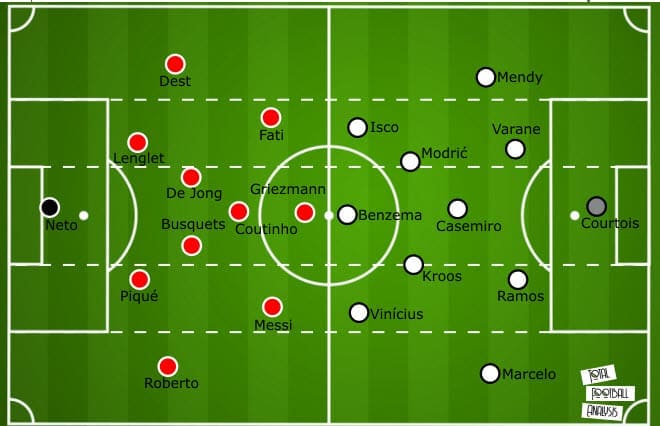
At this point in the season, predicting Zinedine Zidane’s tactics and his lineups is almost like trying to win the lottery. With plenty of injuries and alternations week in, week out, it’s difficult to pinpoint their strongest XI. However, Thibaut Courtois will start in goal and providing he’s fit, Sergio Ramos will partner up Raphaël Varane in the centre of defence.
The full-back positions, however, are more complicated. Both Marcelo and Ferland Mendy are fit and there is a slight chance the Frenchman is deployed on the right side with the Brazilian occupying the left. That may feel like a risky move but we’ve seen it done against Shakhtar already and there’s a logical explanation why that could be the way to go against Barcelona.
If Koeman starts Griezmann, Real Madrid’s left won’t need as much cover since that would leave only Roberto as a potential threat. In that case, playing Marcelo would be the right call and gambling with Mendy on the right to face Fati seems a reasonable decision. In midfield, Casemiro, Toni Kroos and Luka Modrić would offer a well-rounded trio. Of course, Federico Valverde could indeed replace either the German or the Croat to give them more energy and pressing power.
Up front, Karim Benzema and Vinícius Júnior will start but the third man is still a mystery. However, I think Isco could be the chosen one to complete Real Madrid’s 4-3-3 structure.
Barcelona’s attacking tactics vs Real Madrid’s press
This should prove to be a great battle because both teams implement similar tactics, on and off the ball. Both will want to be the aggressors, keeping possession and pressing high so fireworks are guaranteed.
Barcelona will start the game in their 4-2-3-1 system, pushing the full-backs high and then keeping the pivots deep for progression. Depending on Real Madrid’s defensive structure, they will instruct De Jong to join the backline and form a three-man defence.
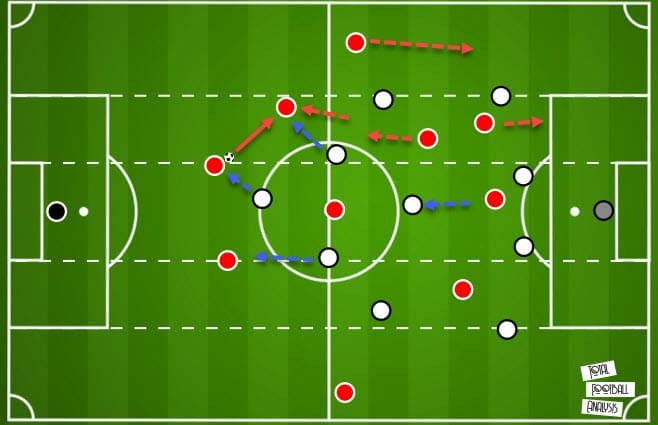
Above, you can see a possible build-up pattern in Barcelona’s tactics and Real Madrid’s defensive approach. We’ve seen Los Blancos start their defence in a 4-1-4-1 system but this changes as they move up to press. Casemiro is often just ahead of the backline but as the opposition recycles the ball wide, the block starts moving.
Benzema is tasked with rushing the ball-carrier while the two central midfielders push higher as well, turning the pressing formation into a 4-3-3. For this to work, Real Madrid would either have to push Casemiro further forward or replace Kroos with Valverde, and both avenues are viable options.
The wide players, in our case Isco and Vinícius, would spread out and cover the full-backs. The structure reverts back to a 4-4-2 once the midfielder on the far side returns to his original position. But when pushing higher, this system gives Real Madrid at least five or six players squeezing the opposition in a heavy man-marking manner.
Interestingly, Ferencváros gave us a blueprint of how to press Barcelona effectively and it involves a very similar system. Notice down below how their 4-1-4-1 turns into a 4-3-3, not too different from Real Madrid’s approach.
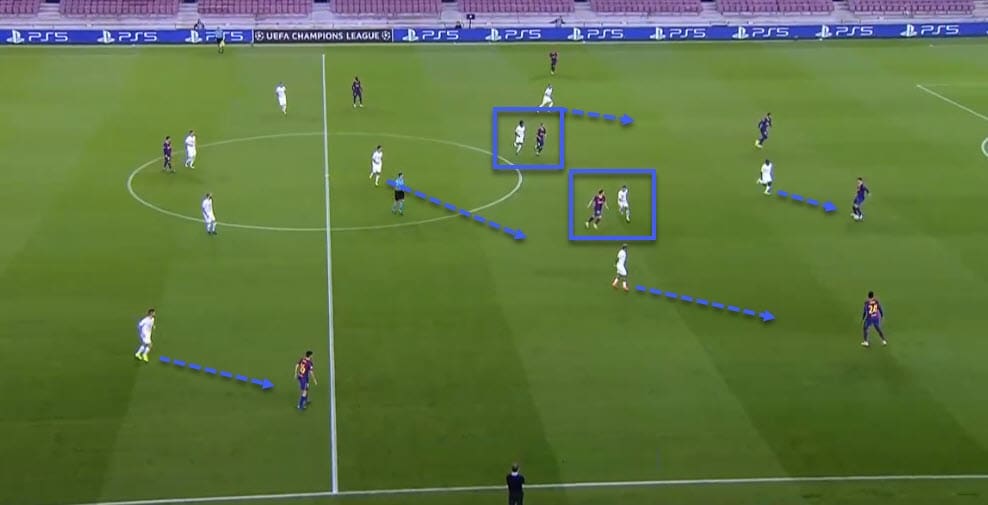
Here, Barcelona have formed a back three with a dropping full-back, which is also an option. In that case, the wide players push up to form a front three pressing squad while the central midfielders man-mark the pivots.
The ball-near winger can also drop off to close the passing channel towards the opposition winger, leaving the pressing to one of the central midfielders. The pivot, who’s positioned just ahead of the backline, would then step up to take over the marking of Barcelona’s pivot, effectively completing the man-marking scheme.
Real Madrid’s ability to effectively squeeze the Catalans will make or break the game for them. They like to deploy a man-marking press but this is largely inconsistent and not always as successful. Below, you can see their six-man pressing squad against Levante.
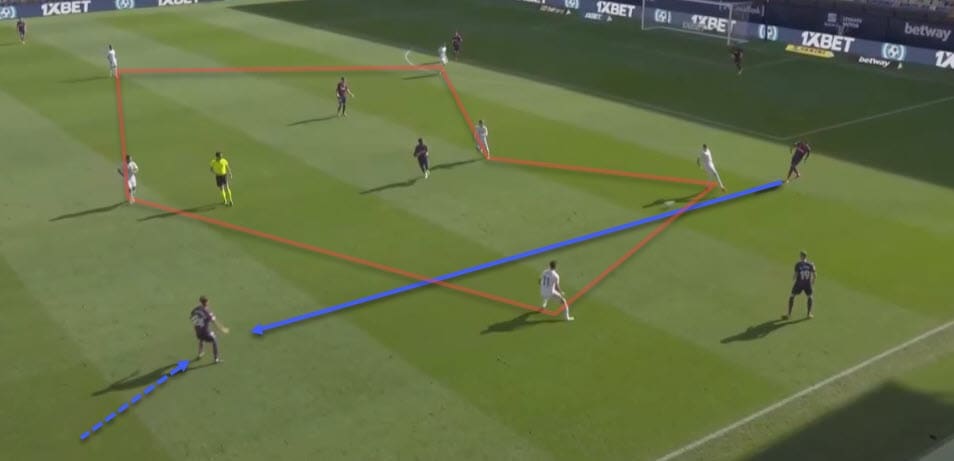
The problem they have is quite obvious – they lack compactness when defending. Levante’s structure also mirrors that of Barcelona perfectly. The double-pivot ahead of the centre-backs, the full-back on the left offering support and a dropping player from an advanced area deal with the lacking press easily.
That might as well been Lenglet on the ball threading the pass towards Fati or Coutinho, both of whom are often positioned in that particular area in the half-space. Barcelona can use that type of movement to their advantage.
Against Getafe, for example, Pedri was the one dropping to overload the midfield and progress the ball. Below, you can see Lenglet finding him with a pass perfectly.
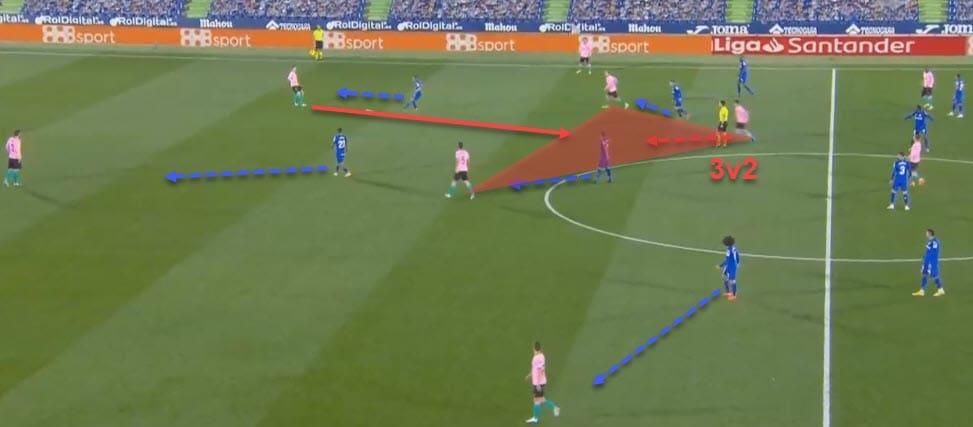
The Catalans, however, don’t always react well to being pressed high, so if Real Madrid can execute their tactics well, it should stifle Barcelona’s build-up play immensely. Both Getafe and Ferencváros gave us decent examples of that, especially the former.
They would collapse on Barcelona and keep their dropping option tightly marked, which often resulted in stopping the attacking altogether. Despite the hiccups, Real are still a good pressing side and depending on Barcelona’s personnel, they can commit with more or less aggression.
Real Valladolid showed us that the press can be bypassed with a well-timed ball in-behind the defensive line, as can be seen below.
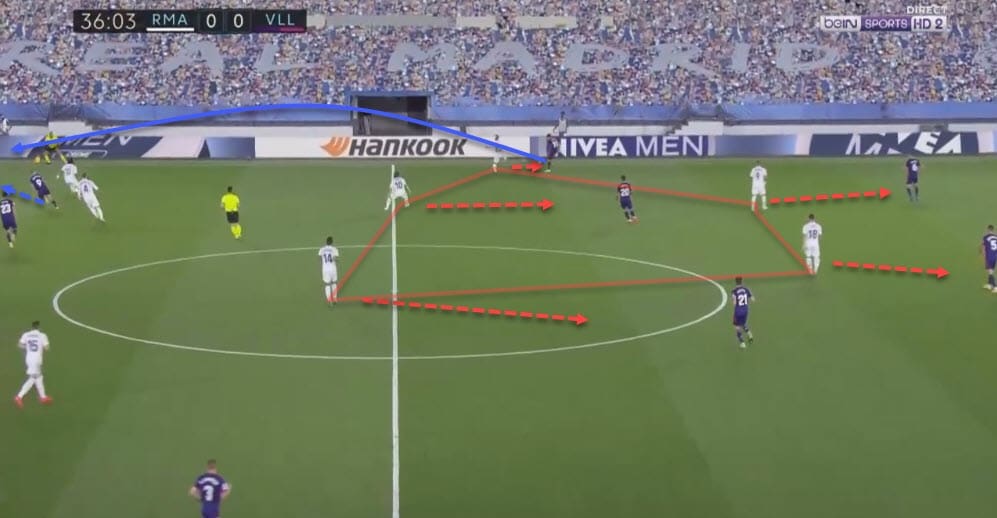
Zidane’s men are in full man-marking pressing scheme, but as long as there are runners up front, Valladolid can escape it with a pass over the top. Barcelona have pace in Fati but the number of runners will depend on whether Trincão or Ousmane Dembélé are also given a chance to play.
Still, the half-space will play a crucial role in the clash. Barcelona love advancing through it and Real Madrid have a knack of keeping it unmarked. Even though Zidane has turned Los Blancos into one of the best defensive teams in LaLiga in the latter stages of 2019/20, some of that solidity has disappeared now.
We go back to the Levante game for more examples. Below, you can see how Real’s 4-4-2 structure leaves a lot of openings for the hosts to advance through the half-space.
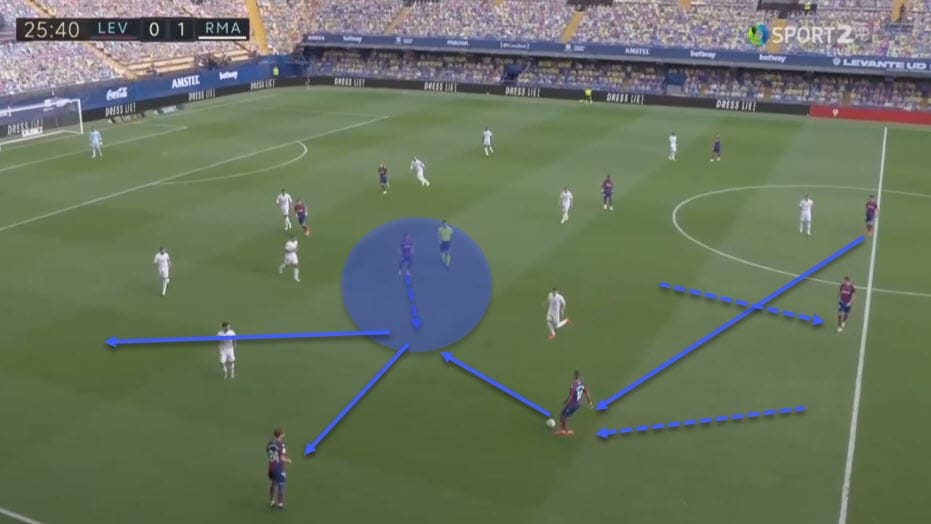
That takes us back to our previous point in this tactical analysis and that’s the lack of compactness for the Whites. If given so much room, Barcelona will cut through the lines, especially with the likes of Lenglet, De Jong or Busquets on the ball.
Here’s a perfect example of how that might play out on Saturday. Coutinho drops deeper through the half-space to receive the pass. His movement drags the midfielder with him – in our case, this would likely be Casemiro – and also attracts the attention of the wide player, likely Isco.
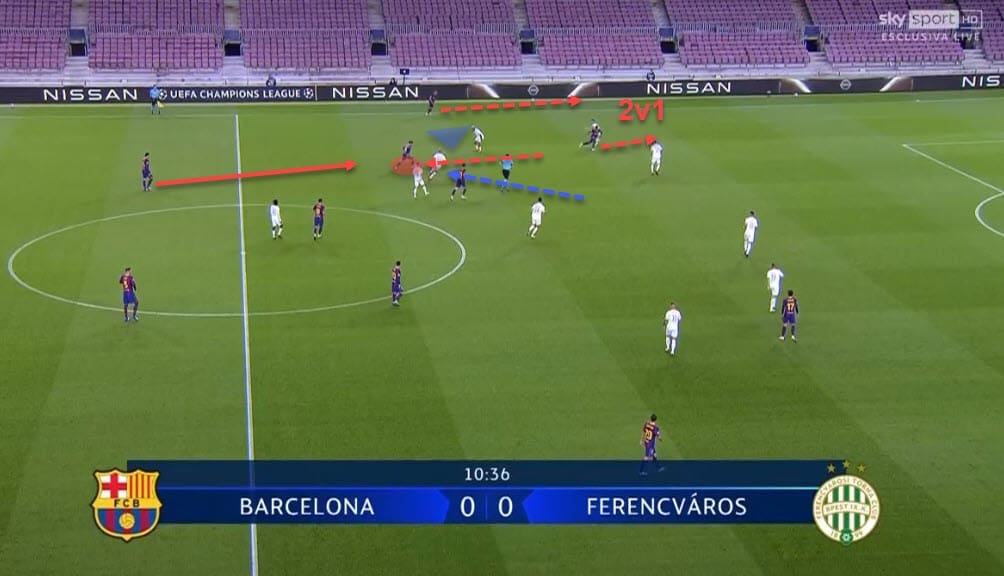
At the same time, both Fati and Dest are already making runs in-behind, forming a 2v1 scenario on the opposition full-back. That type of movement is likely for the Catalans, especially considering Real Madrid often defend in a similar structure to the one we see above.
Staying compact and protecting the half-space both when pressing and in deeper blocks will be crucial for the visitors on Saturday.
Real Madrid’s attacking tactics and Barcelona off the ball
Predicting Real Madrid’s lineup was a tall task in itself but the same goes for their tactics. Zidane doesn’t seem to have a clear gala XI, and that immediately has an impact on the approach in-game as well. However, there are certain patterns that we can connect to the personnel the Frenchman could use.
It has to be said, however, that the following tactics do depend on the midfield the most. With Kroos and Modrić starting, Real Madrid get more control and build-up prowess but lose out on the energy and forward runs Valverde offers.
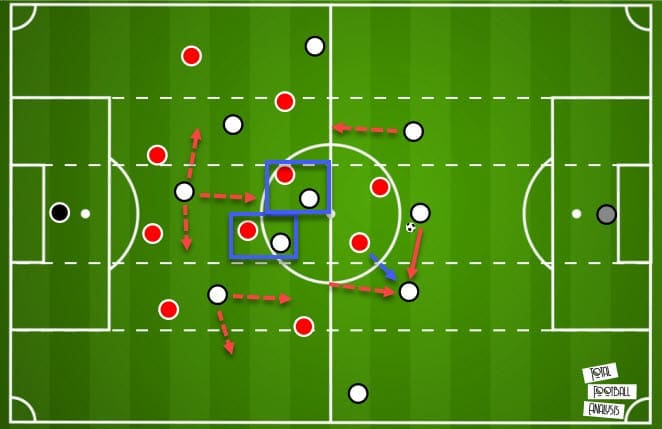
Above, you can see how their build-up could work against Barcelona’s 4-4-2 mid-block. When faced with a pressing squad of two, just like their opposition themselves, Real will opt to drop one of the midfielders into the backline. This can be either Kroos on the left or Modrić down the middle, between the centre-backs.
Either way, the purpose remains the same – create superiority in the first phase of build-up. In this instance, Messi will be accompanied by one more energetic presser to face the ball-carrier. The Argentine will likely conserve energy at most times and try and use his cover-shadow to close passing channels. The other part of the pressing duo will track the ball and run a lot.
This also depends on Barcelona’s structure in defence. They do like to press high and will often do so in a 4-2-3-1 structure that can also look like a 4-1-4-1, depending on the pivots’ movements. Usually, they are staggered with one staying deeper than the other. The initial graphic showed us that they like to man-mark the opposition’s midfielders and this is likely to be the case against Real Madrid as well.
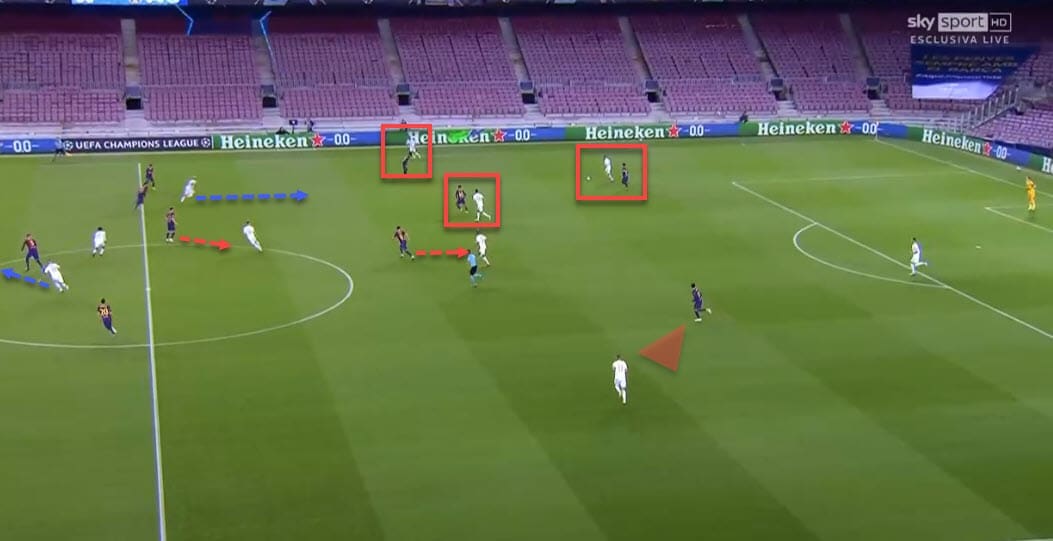
Above, you can see that structure in action. Notice the difference in positioning between De Jong and Pjanić as the latter moves up to cover his man. This high up the pitch, Real can expect Messi to press more as well and dropping Kroos or Modrić is certainly an option to tackle this.
However, shifting the ball to Varane and then letting him run into space could be the preferred way to go. The Frenchman is extremely comfortable on the ball and can then find the dropping forwards or the midfielders in the half-space, just as you could see in the previous example.
Barcelona’s pivots can also be manipulated to jumping forward, which is especially effective when you play with either dropping wingers or if you can overload the other pivot that remains deeper.
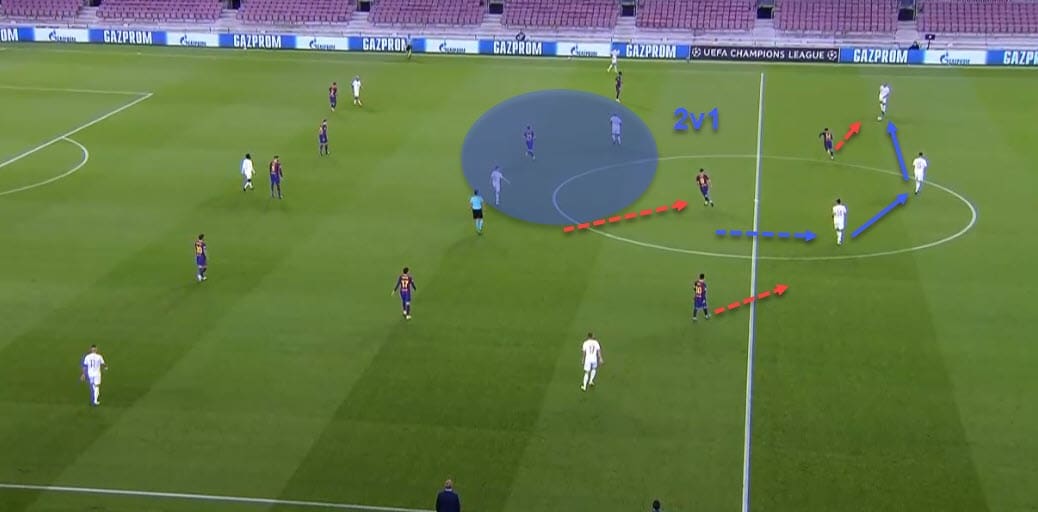
Notice above how that happened to De Jong as Pjanić stepped up to chase his man high up the pitch. Real Madrid can drop one of Kroos and Modrić to activate Barcelona’s press, lure the pivot higher and then use their centre-backs’ passing to advance.
Even though Ferencváros didn’t necessarily have the tools to progress easily in the example above, Real Madrid have the quality to execute that play. Again, notice below how Sevilla do the same thing as they drop their players from advanced positions to overload the pivot and progress the play in the face of a high press.
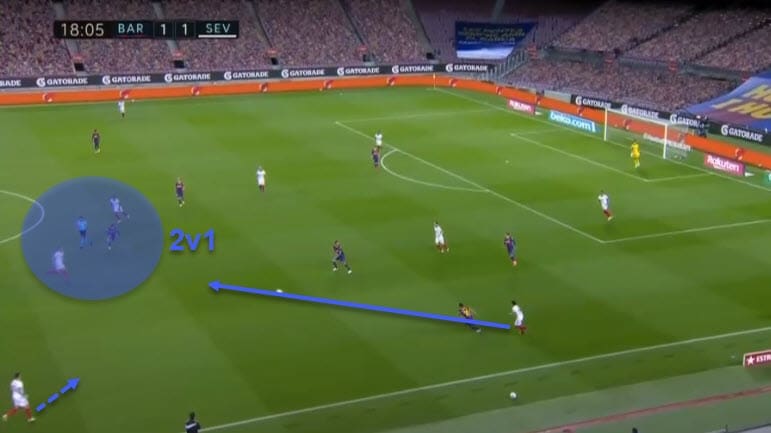
This is certainly something Zidane can make use of. Barcelona leave a lot of space behind their backs when pressing, similarly to Real Madrid’s issues, and their rest-defence – which is usually the pivots and a full-back at best – can easily be overrun or bypassed.
Similarly, long switches and balls in-behind can cause them a lot of damage, especially since their backline is extremely slow. With the likes of Vinícius on the pitch, that is a real avenue to explore for Zidane’s tactics. But overloading their full-backs can also be effective.
Below, you can see how Celta Vigo do that straight from their goalie as Barcelona commit players high up the pitch. The forwards drop and drift wide, ensuring a decisional crisis and establishing superiority on the flank.
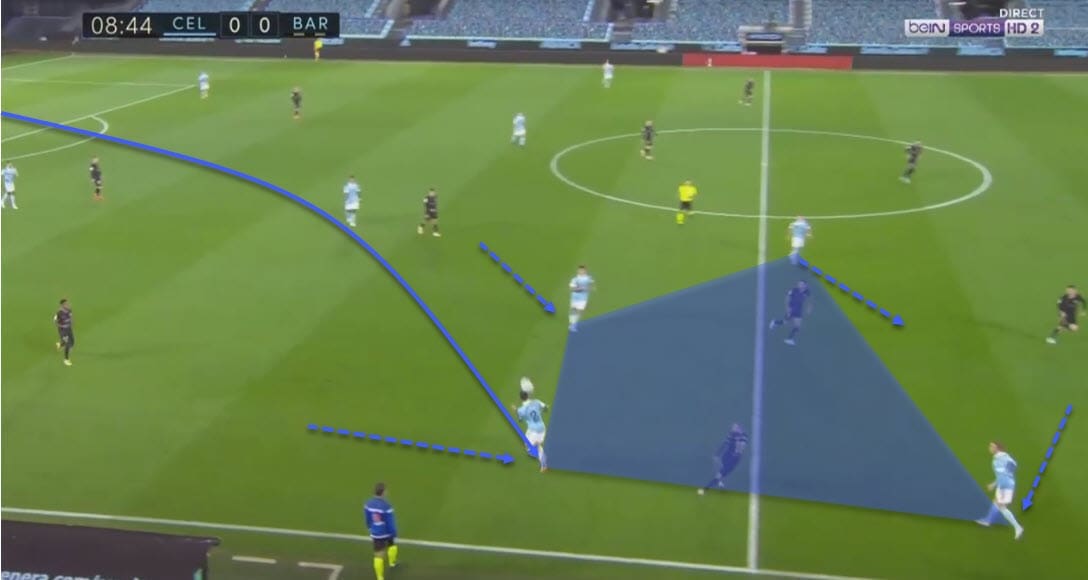
Real Madrid can look to do the same thing, especially with Benzema’s flexibility. The Frenchman will often drift wide or drop deep, depending on the situation. His interchange and combinations with the winger and the full-back are crucial to Los Blancos’ dynamic attack.
In the example below, you can see Varane on the ball and the movement of the aforementioned trio in the final third. Lucas Vázquez drops to drag the defender and that’s a cue for Benzema and Nacho to burst into space, overloading the flank and exploiting the unmarked area.
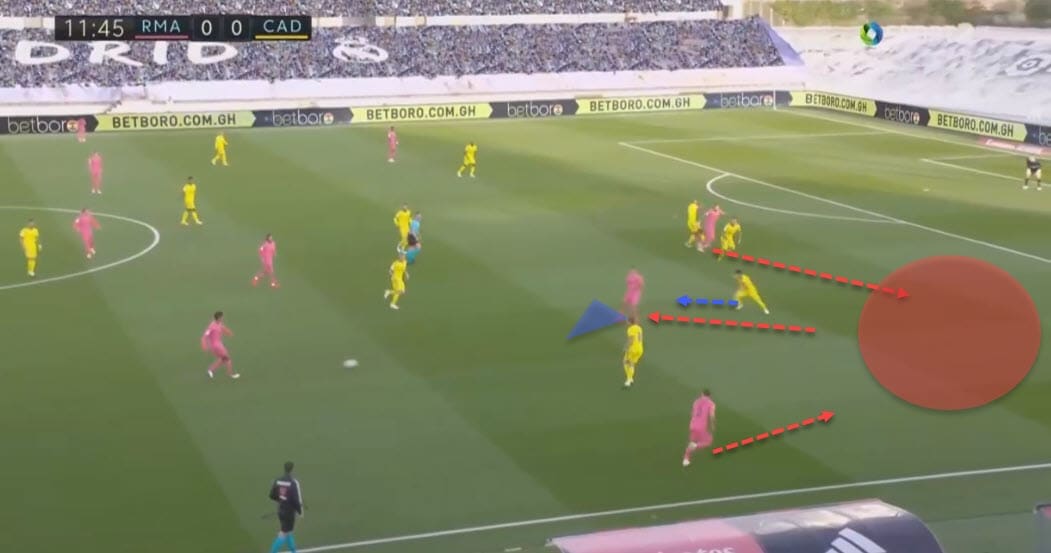
Given Barcelona’s man-marking tendencies, especially in the backline, this type of play can be used against them. When combined with the speed of the Madridistas and the lack thereof with the Catalans, it could prove a deadly weapon.
Final prediction
Making a bold prediction is always tough but both teams seem to be struggling at the moment. Still, it should be a good tactical battle nonetheless.
We’re going for a 2-1 Barcelona victory, courtesy of the home-side advantage and Real’s inefficiency in front of goal. However, keeping a clean sheet with their shaky defence will be a tough task for the Catalans.





Comments